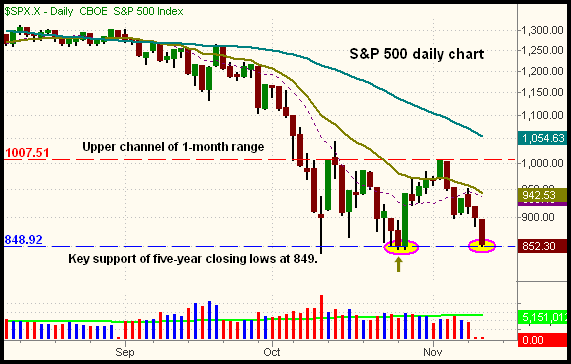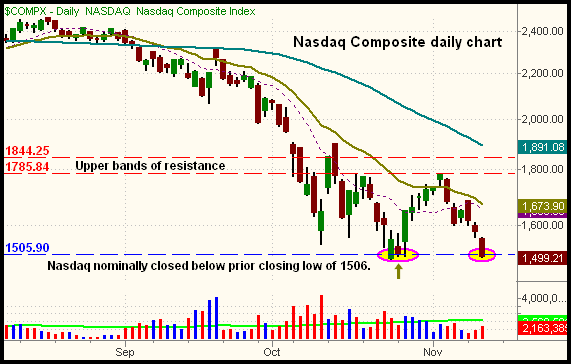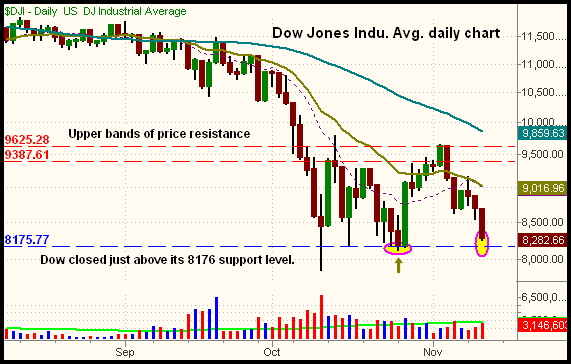|
The Wagner Daily ETF Report For November 13
Building on selling pressure from Tuesday's breaks of short-term support levels, the major indices fell sharply lower yesterday. Closing near the bottom of their month-long bases of consolidation, the S&P 500 and Nasdaq Composite suffered identical losses of 5.2%. The blue-chip Dow Jones Industrial Average plunged 4.7%. The Russell 2000, which rallied the most on the bounce off last month's lows, also lost the most yesterday. The small-cap index tumbled 6.2%. The S&P Midcap 400 settled 5.5% lower. After drifting lower throughout the entire session, all the main stock market indexes closed at their lowest levels of the day.
Turnover spiked higher across the board, causing both the S&P 500 and Nasdaq Composite to register their second straight "distribution days." Total volume in the NYSE increased 19%, while volume in the Nasdaq similarly rose 14% above the previous day's level. In the S&P 500, it was the fourth instance of higher volume selling in recent weeks. Combined with a full retracement of recent gains, the fourth "distribution day" in the S&P 500 basically put the nail in the coffin of the recovery attempt off the October 2008 lows. Yesterday's bearish numbers were also confirmed by atrocious market internals. Declining volume trounced advancing volume by a ratio of more than 25 to 1 in both the S&P and Nasdaq. This tells us the selling was extremely broad-based, sparing no specific industry sectors.
In the November 11, 2008 issue of The Wagner Daily, we discussed the short-term trade that was setting up in the broad market. Specifically, we were looking for either a breakout above, or breakdown below, the broad market's trading range of the preceding three days. Since the broad market was hovering near the middle of its intermediate-term sideways trading range, we anticipated that a breakout above the preceding three-day range would send stocks to test their highs of the past month, while a breakdown below the same range would likely send stocks to test their lows of the past month. Because the major indices fell below their three-day trading ranges later that day, then completed the descent to test their intermediate-term lows yesterday, our analysis indeed proved to be 100% correct. However, tricky market action on November 11 prompted us to pass on selling short that day. Instead, we viewed the late-day rally of November 11 as a "bear trap" that represented a false breakdown below the range. Further, the inverse head and shoulders pattern discussed in yesterday's commentary provided another reason to modestly test the water on the long side after the afternoon rally. The inverse head and shoulders patterns are technically still alive, as the lows of last month (the "heads" of the pattern) are still intact. However, the odds of the bullish pattern now following through to the upside are minimal.
As discussed above, the major indices have fallen to test their lows of last month. Below, support of the October 2008 lows is shown on daily charts of the S&P 500, Nasdaq Composite, and Dow Jones Industrial Average. The blue dashed horizontal lines are the closing lows, while the red dashed horizontal lines are the closing highs of the month-long bands of sideways consolidation:



Comparing the charts above, the S&P 500 is sitting just a few points above last month's closing low, while the Dow has been holding up slightly better. The Nasdaq Composite already set a new five-year closing low, but only by a few points; not a wide enough margin to definitively declare a break of support. Obviously, these prior lows represent a very pivotal area of support; a break below these levels could easily lead to another leg lower and fresh five-year lows. Still, because this is such a major area of support, we don't expect a break of these lows to come without a bit of gyration and fakeout moves to the downside. Trying to properly time a short sale of a breakdown of these levels, without getting stopped out, could be challenging. There's also a good chance these prior lows will lead to another significant rally back towards the middle of the recent trading ranges. Frankly, there's no need to take action either way at the moment.
As per our earlier explanation, we did not participate in short selling this week's move to the downside. However, the model ETF portfolio of this newsletter ultimately did not suffer, and is already outperforming the S&P 500 by a wide margin this month. Though we realized losses in UWM and IBB yesterday, we locked in a gain of more than 4 points on our FXY (Japanese Yen) position. Originally taken as a hedge against our long positions, FXY performed as expected by rallying sharply while the market sold off yesterday. Our two remaining positions, DGP (Gold) and LQD (Corporate Bonds) are also showing a net wash at the moment. While the S&P 500 has already fallen another 11% in November, our model ETF account is showing a loss of just 0.5% (based on positions closed this month). We don't always catch every "nook and cranny" move in the markets, especially when we don't like the reward-risk ratios, but the goal of this newsletter is to preserve capital during the tricky periods so that we can capitalize on the abundant opportunities in good times. If you are a nimble, astute trader, short selling can be profitable, but capital preservation should be your number one priority in the current environment!
Open ETF positions:
Long - LQD, DGP
Short - (none)
Deron Wagner is the Founder and Head Trader of both Morpheus Capital LP, a U.S. hedge fund, and Morpheus Trading Group, a trader education firm launched in 2001 that provides daily technical analysis of the leading ETFs and stocks. For a free trial to the full version of The Wagner Daily or to learn about Wagner's other services, visit MorpheusTrading.com or send an e-mail to deron@morpheustrading.com.
|